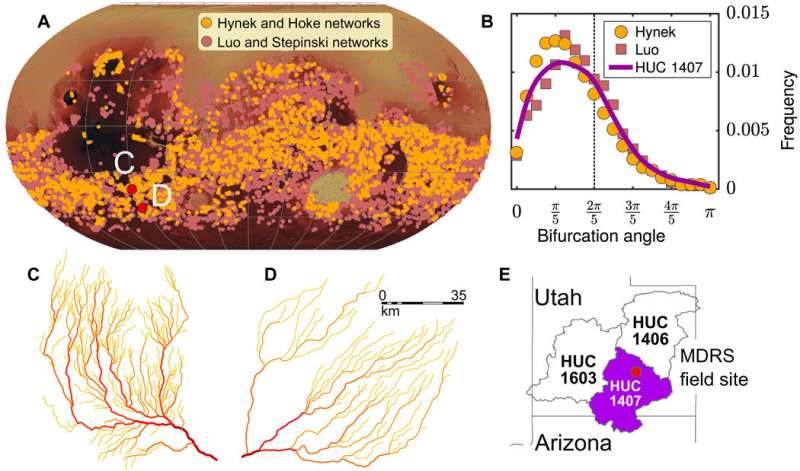June 28, 2018 report
Study suggests branching networks on surface of Mars due to heavy rainfall

A trio of researchers with ETH Zurich and the University of Chicago has found evidence that suggests narrow channel networks seen on the surface of Mars are due to heavy rainfall runoff. In their paper published on the open access site Science Advances, Hansjoerg Seybold, Edwin Kite and James Kirchner describe their study of the channel networks and comparisons they made with similar formations found here on Earth.
As the study notes, prior study of narrow channel networks on Mars has led researchers to believe they were likely created by a standing body of water. Other possibilities include groundwater sapping, fluvial runoff or even ice melting. Lack of direct evidence supporting any of the theories, however, has led to continuing debates. The researchers with this new effort have jumped into the fray by suggesting an alternative theory based on observations of Earth geography. They suggest work done by other researchers studying channel networks here on planet Earth offers a blueprint for the origins of channels on Mars. In that prior effort, other researchers had discovered a connection between the dryness of an area and the branching angles characteristic of some channel networks. Those in more arid areas, they found, tended to branch at narrower angles than did those in places exposed to more rainfall.
To find out if such evidence might be applicable to Mars, the researchers studied datasets containing information regarding the channel branching seen on Mars. In comparing two datasets from separate studies, they found similarities in descriptions of branching angles on Mars, both of which were compatible with the findings by the team studying channel networks on Earth—namely, that they had narrow angles. This, the researchers suggest, indicates a similar process was involved.
On Earth, the narrow channels resulted from infrequent rainfall runoff. Successive rainfalls led to deepening of the channels to their current depth. The researchers suggest the same is likely true for the branching networks on Mars. Rather than being formed by subtle movements of groundwater, they were likely carved into the ground by rushing water. Such an occurrence, they further note, would suggest that Mars had a very active hydrologic cycle.

More information: Hansjoerg J. Seybold et al. Branching geometry of valley networks on Mars and Earth and its implications for early Martian climate, Science Advances (2018). DOI: 10.1126/sciadv.aar6692
Abstract
Mars' surface bears the imprint of valley networks formed billions of years ago. Whether these networks were formed by groundwater sapping, ice melt, or fluvial runoff has been debated for decades. These different scenarios have profoundly different implications for Mars' climatic history and thus for its habitability in the distant past. Recent studies on Earth revealed that valley networks in arid landscapes with more surface runoff branch at narrower angles, while in humid environments with more groundwater flow, branching angles are much wider. We find that valley networks on Mars generally tend to branch at narrow angles similar to those found in arid landscapes on Earth. This result supports the inference that Mars once had an active hydrologic cycle and that Mars' valley networks were formed primarily by overland flow erosion, with groundwater seepage playing only a minor role.
Journal information: Science Advances
© 2018 Phys.org





















